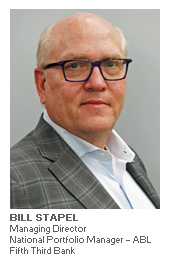
In this new series, Charlie Perer engages with top asset-based lending Portfolio Managers to explore the evolving nature of their role, the current credit environment, and broader market trends. This series aims to provide insights from industry leaders who specialize in portfolio management, offering their perspectives on market conditions and strategies for positioning their businesses for success.
Here to tell the story are Bill Stapel, National Portfolio Manager ABL at Fifth Third Bank and Glenn Bartley, SVP, ABL Managing Director of Portfolio at The Huntington National Bank.
Charlie Perer: Please briefly introduce yourselves.
Glenn Bartley: I am the ABL Managing Director of Portfolio with Huntington Business Credit. I currently manage 28 employees responsible for underwriting, monitoring credit facilities, implementing work-out, exit and relationship strategies for 170 borrowers in a $8.0 billion portfolio of asset-based loans. Prior to HNB, I was employed as the SVP, Manager of ABL Portfolio for First Merit Bank from June 2009 until the HNB acquisition completed in August of 2016. In summary, I have thirty-nine years of asset-based lending experience and have held portfolio management and underwriting positions involving workout and exit strategies with CIT, GE Capital, National City Business Credit, Republic Financial, Sanwa Business Credit and LaSalle Business Credit.

Bill Stapel: I’m the National Manager for Fifth Third Bank’s ABL Portfolio with responsibilities of managing the ABL Portfolio and Operations Teams. I have more than 35 years of asset-based lending experience. Through my career, my roles have included leading the lines of businesses, Senior Credit Officer, Underwriting, Portfolio Management, and field examinations at various organizations. I joined Fifth Third through its acquisition of MB Financial which acquired Cole Taylor. My prior institutions were Heller Financial, StanChart Business Credit – which was acquired by LaSalle Bank, and then Bank of America.
Perer: How do you think about risk in today’s market where there has never been more uncertainty regarding recession risk?
Bartley: I think about our risk in a dynamic way having been through multiple cycles with each inflicting very different stresses on our borrowers. Our team here has been together for 20 plus years, so our ability to understand and manage risk is more tactile than most. Right now though, it’s still a tale of two economies as we see many companies teetering while at the same time a strong M&A pipeline is forecasted for next year. Ultimately, every downturn or recession is different and has different economic causes such as inflation, interest rates and disposable income that are currently causing stress across the consumer products sector for wholesalers and retailers within the low- to middle income consumer.
Stapel: When I think about market risk on the portfolio, it’s more on what factors will be driving demand for each segment of the portfolio. With an economy being 70 percent based on consumer demand, as consumer confidence wanes so does the economy. Today we are seeing a slowdown in consumer spending as there was so much uncertainty with the election . Hopefully now that the election is over, we will have less uncertainty and with the low level of unemployment consumers will feel more confident and continue to spend. We have seen the slowdown in consumer spending but with our procedures in place of highly monitoring each borrower, it allows us to collaborate with the borrower.
Perer: Where are portfolios today in comparison to pre-COVID?
Stapel:From a credit quality view, criticized assets are at similar levels, but total excess availability portfolio wide has increased to over 50 percent from 44 percent in 2019. It should be noted that on the lower middle market deals (deals under $25MM in commitments) have had the biggest improvement in excess availability going from 18 percent in 2019 to 35 percent in 2024. I believe the improvement stems from balance sheets shrinking (line utilization is down to 48 percent from 61 percent in 2019), the profits that were generated during COVID and the government support during COVID.

Bartley: Portfolio are recovering but are not at Pre-covid levels. During the late stages of COVID borrowings and utilization increased due to inventory glut and we are now at the trough of the inventory de-leveraging so on one-hand it’s great that most bank ABL groups have de-risked the challenge is that borrowings and utilization are down with balance sheets shrinking. They are now back on the rise.
Perer: What percent of an ABL portfolio should be rated “criticized”?
Bartley: Criticized portfolios are usually 10 to 20 percent due to the following reasons: supply chain issues, consumer stress and inflation. During early COVID, companies had liquidity from decreasing inventory levels due to supply chain disruption and strong consumer demand as a result of the government stimulus programs implemented at the onset of COVID. Criticized levels fell to 3 percent.
Today criticized levels are in the range of 10 to 15 percent. We have now been through three historical cycles and the peak to trough has been similar in all of them.
Stapel: ABL in a bank setting used to provide prospects and existing customers with an additional option from cash flow solutions. It is also used to retain clients who are going through a transition period where we can be more patient with the borrower due to the collateral coverage of loans and higher level of monitoring. The percentage that “should be” rated criticized is dependent on the economic cycle period we look at. During times of entering into or during a recession, I can see an ABL portfolio being as high as 35 percent, during the good times the portfolio’s criticized should be under 10 percent.
Perer: How different is the job today than say 10 years ago?
Stapel: The basic tenets of ABL haven’t changed over the decades I have been in the business. We need to understand the borrower’s business and the collateral we are lending against. In the regulated bank environment, there has been an increased focus on risk oversight, compliance and making sure the deal has the proper risk rating.
Bartley: Speed and technology. Consolidation has driven competition, which has in turn increased response time which just adds pressure to any team. We are now a multi-billion group still run by the same team that is hands on, but the response times seem to get shorter and shorter. Technology has certainly helped as access to information is easier. Systems to track collateral, cash and assets have increased productivity. In addition, the portfolio managers could not have worked remotely as they did during COVID. Return to office has resumed but gives the portfolio manager the ability to balance work and personal responsibilities.
The core tenets of the job are still the same and it still takes many years to become a skilled PM, but the pace is just faster, which in turn does add stress on occasion.
Perer: What are the factors driving the change over the past decade?
Bartley: Simply put more options, especially from the non-bank world. The emergence of private credit and new specialty finance companies have led to refinancing exits from Bank ABL groups. I should also add the increase in investment banks with the ability to run a dual process for both a sale and refinancing. Liquidations and asset sales were more prevalent than today. They have not gone away entirely, but there are fewer of them due to the amount of capital out there from both PE and credit.
Stapel: Improvement in technology has allowed us to obtain, monito, and analyze more information to better understand our customer and how their assets perform, which allow an ABL deal to provide more liquidity. Also driving changes in the regulated bank environment is the increased regulatory oversight.
Perer: Is being a PM the job with the most accountability in lending?
Bartley: The PM job has the most responsibilities of any lending job. The PM handles relationship responsibilities, sells ancillary services, monitors industry trends, and monitors collateral and financial performance across multiple relationships. The never ending to do list and great PMs typically have a strong ability to control the outcome. It’s a job that requires a strong temperament, ability to act quickly and a person capable of making very tough decisions without complete information. Everyone understand the plight of the BDO, but few understand the ultimate responsibility of PMs to safeguard capital in what is a make it in nickels and lose it in dollars business.
Stapel: Every position in the ABL team has a shared level of accountability, but the PM job is the one that has very few, if any slowdowns, as there is always some request to be underwritten or covenant default to be addressed.
Perer: Has increased competition affected risk-taking and how has that affected the PM role?
Stapel: From a regulated bank standpoint, I believe the risks that are being taken are similar. The differentiation comes down to the people and their ability to listen to the customer and produce a solution that works for the company and their institution.
Bartley: The margin of error has decreased and the PM has to proactively monitor performance and be ready to implement reserves when the situation requires protecting the loan assets. Higher advance rates are the new norm as the market is too efficient and non-bank pricing is coming close to bank pricing, especially when non-banks can provide more structure. This trend is only going to continue and the ultimate separation from good to great firms is the strength of their portfolio capabilities. We have the ability to effectively manage risk based on our decades of team continuity and proactive system.
Perer: Is the ABL industry prepared for another 2008 cycle given every group seems to be focused on expense management?
Stapel: With over a decade since the great recession, a lot of seasoned veterans of the ABL industry have retired and those that have entered the industry have not seen a troubled time and how we need to react. While I believe technology has significantly improved, which provides more reliable data to make decisions, if one doesn’t recognize downward trends in collateral performance and implement the appropriate reserves, there will be losses.
Bartley: As an industry to be blunt the answers is no, but like all cycles younger talent will step up and the industry will survive. Increased oversight has led to more diligent monitoring and proactive account management. However, 2008 was a different cycle as it was driven by the financial crisis. Many of the experienced PMs have either retired or left the industry. Many of the current PMs have never been through a cycle as evidenced by the increased interest rate hikes that have stressed cash flows. Whether the industry is prepared, only time will tell.
Perer: Are bank and non -bank workout groups that are thin on talent, losing experienced credit people to turnaround firms and private credit groups in need of talent?
Bartley: There will always be movement of talented workout professionals. The days of working for one organization your whole career are in the distant past. It still is about working relationships with your peers as it takes a team to operate a successful ABL group.
Perer: What is a perception you have about today’s ABL market that is not widely shared?
Stapel: ABL field exam experience is invaluable training in developing an ABL lender.
Bartley: ABL lenders are some of the most versatile lenders. ABL lenders are cash flow lenders and asset lenders. ABL lenders can often determine the companies problems before management. ABL is no longer the lender of last resort.